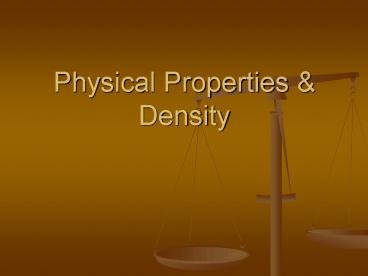Physical Properties - PowerPoint PPT Presentation
1 / 27
Title:
Physical Properties
Description:
Think of it like using weight and height for babies. 95th percentile for height, 30th for weight ... to get the units correct. Do this before you divide. ... – PowerPoint PPT presentation
Number of Views:269
Avg rating:3.0/5.0
Title: Physical Properties
1
Physical Properties Density
2
Physical Properties
- How would you describe someone or something?
- The weight, height, length, eye color, hair
color, etc. would be good items to use to
describe someone. - It is easy to identify chemicals, compounds and
elements based on their physical properties also. - These include color, odor, and state of matter to
name a few.
3
Mass
- A physical property that every object possesses
is mass. The amount of mass in a person will
never change when the object is moved from place
to place.
4
Weight
- A physical property that is related to
mass is weight. The weight of a dog will change
if it is moved to Uranus because weight is
determined by gravity.
5
Gravity
- The greater the mass of an object, the more
strongly it attracts other objects. The weight of
a dog would be heavier on earth than on the moon,
because the earths mass is larger than the
moons
6
Physical Changes
- Some physical changes would be
- boiling of a liquid
- melting of a solid
- dissolving a solid in a liquid to give a
homogeneous mixture a SOLUTION.
Physical changes do not change the identity of
Substances
7
Chemical Change
Click for movie
2 H2(g) O2 (g) -- 2 H2O(g)
8
Chemical Change
- Burning hydrogen (H2) in oxygen (O2) gives H2O.
- Chemical change or chemical reaction
transformation of one or more atoms or molecules
into one or more different molecules.
9
Density
- Another physical property that can be used is
density. - Density is a measure of the relationship between
mass and the volume it occupies. - Think of it like using weight and height for
babies - 95th percentile for height, 30th for weight
10
DENSITY - an important and useful physical
property
Platinum
13.6 g/cm3
21.5 g/cm3
2.7 g/cm3
11
Buoyancy and Density
- One factor that density controls is floating and
sinking. - Objects float and sink because of their density.
- The density of water is 1.0 g/mL.
- The density of cork is 0.34 g/mL.
- The density of lead is 13.9 g/mL.
12
Buoyancy and Density
- Compounds that are less dense than water float.
- Name some other items that will float in water.
- Compounds that are more dense than water sink.
- Name some other items that will sink in water.
13
Density Units
- Density can be defined as the unit mass per unit
volume. - Density Mass/Volume
- Density is recorded as g/mL.
- Mass is measured in g.
- Volume is measured in mL.
14
Density Units
- Density, Mass, / Volume,
- g/mL g / mL
- You may have to convert to get the units correct.
Do this before you divide.
15
Density
- What is the density of 5.0 g of tin that has a
volume of 1.2 mL? - Density Mass / Volume
- ? g/mL 5 g / 1.2 mL
- 4.2 g/mL
16
Density
- What is the volume of 5.0 g of tin that has a
density of 4.6 g/mL? - Density Mass / Volume
I prefer to solve for the unknown before putting
in the numbers and units. (Less writing)
17
Density
- X 5 g / 4.6 g/mL
Grams cancel out and you are left with mL. Try
the math.
- X 1.1 mL
If at this time while doing other problems, if
the units are not correct, you are wrong and need
to restart the problem
18
Lab Results
- Density of rectangular bars
- Density of granite
19
Density of Some Common Substances
- Substance Density (g/cm3)
- Air 0.0013
- Feathers 0.0025
- Wood(Oak) 0.6 - 0.9
- Ice 0.92
- Water 1.00
- Bricks 1.84
- Aluminum 2.70
- Steel 7.80
- Silver 10.50
- Gold 19.30
Answers from density lab Brass, iron, copper,
and aluminum
20
Density Review
21
Floating Liquids
- Which diagram represents the liquid layers in
the cylinder? - (K) Karo syrup (1.4 g/mL), (V) vegetable oil
(0.91 g/mL,) (W) water (1.0 g/mL) - 1) 2) 3)
K
W
V
V
K
W
W
V
K
22
Solution
- (K) Karo syrup (1.4 g/mL), (V) vegetable oil
(0.91 g/mL,) (W) water (1.0 g/mL) - 1)
V
W
K
23
PROBLEM Mercury (Hg) has a density of 13.6
g/cm3. What is the mass of 95 mL of Hg?
- Convert volume to mass
Note 1 ml is the same as 1 cm3
24
Bloody Density
- If blood has a density of 1.05 g/mL, how many
liters of blood are donated if 575 g of blood are
given? - 1) 0.548 L
- 2) 1.25 L
- 3) 1.83 L
Caution The units are liters!
25
Solution
- 1)
- Unit Plan g mL L
- 575 g x 1 mL x 1 L 0.548
L - 1.05 g 1000 mL
26
Light or Heavy Metals
- You have 3 metal samples. Which one will
displace the greatest volume of water? - 1 2 3
- Discuss your choice with another student.
25 g Al 2.70 g/mL
45 g of gold 19.3 g/mL
75 g of Lead 11.3 g/mL
27
Solution
- 1) 25 g Al x 1 mL 9.2 mL
2.70 g
25 g Al 2.70 g/mL































